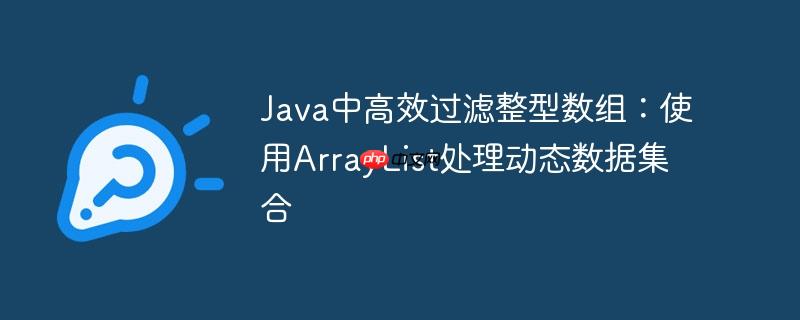
在java中,int[] 是一种固定大小的数据结构,一旦创建,其长度便无法改变。当我们需要根据特定条件(例如大于某个阈值)从一个现有数组中筛选出符合条件的元素,并将其存储到一个新的数组中时,固定大小数组的这一特性会带来挑战。我们无法预知筛选后会有多少个元素,因此很难提前确定新数组的准确大小。
一个常见的错误尝试是,在循环中根据筛选出的元素动态地重新创建数组并尝试复制元素。例如,以下代码片段展示了这种不恰当的处理方式:
public int[] getValuesAboveThreshold(int threshold) {
int[] a = new int[] { 58, 78, 61, 72, 93, 81, 79, 78, 75, 81, 93 };
int temp[] = new int[1]; // 初始数组大小不确定
for (int d : a) {
if (d > threshold) {
// 每次找到符合条件的元素,都重新创建一个更大的数组
temp = new int[temp.length + 1];
// 错误:这里的内层循环会用当前d的值填充整个新创建的temp数组
for (int i = 0; i < temp.length; i++) {
temp[i] = d;
}
}
}
return temp;
}上述代码的问题在于:
为了克服固定大小数组的局限性,Java提供了 ArrayList 这一动态数组实现。ArrayList 属于 Java 集合框架的一部分,它可以在运行时自动调整其内部容量以适应元素的增删。这使得它成为处理不确定数量元素集合的理想选择。
以下是使用 ArrayList 优雅地实现阈值过滤的代码示例:
立即学习“Java免费学习笔记(深入)”;
import java.util.ArrayList;
import java.util.List; // 推荐使用接口类型声明
public class ArrayFilter {
/**
* 根据指定阈值过滤整型数组,并返回符合条件的元素列表。
*
* @param threshold 过滤阈值,只有大于此阈值的元素才会被包含在结果中。
* @return 包含所有大于阈值元素的ArrayList。
*/
public static ArrayList<Integer> getValuesAboveThreshold(int threshold) {
// 原始数据数组
int[] a = new int[] { 58, 78, 61, 72, 93, 81, 79, 78, 75, 81, 93 };
// 创建一个ArrayList来存储符合条件的元素
ArrayList<Integer> resultList = new ArrayList<>();
// 遍历原始数组
for (int d : a) {
// 判断元素是否大于阈值
if (d > threshold) {
// 如果符合条件,则将其添加到ArrayList中
resultList.add(d);
}
}
// 返回包含过滤后元素的ArrayList
return resultList;
}
public static void main(String[] args) {
int threshold = 78;
ArrayList<Integer> filteredValues = getValuesAboveThreshold(threshold);
System.out.println("Output for values above " + threshold + ": " + filteredValues);
// 预期输出: Output for values above 78: [85, 93, 81, 79, 81, 93]
}
}代码解析与ArrayList优势:
使用 ArrayList 的主要优势在于:
对于Java 8及更高版本,可以使用Stream API来更简洁地实现过滤操作:
import java.util.Arrays;
import java.util.List;
import java.util.stream.Collectors;
public class StreamFilterExample {
public static List<Integer> getValuesAboveThresholdWithStream(int threshold) {
int[] a = new int[] { 58, 78, 61, 72, 93, 81, 79, 78, 75, 81, 93 };
return Arrays.stream(a) // 将int[]转换为IntStream
.filter(d -> d > threshold) // 过滤元素
.boxed() // 将int转换为Integer,以便收集到List<Integer>
.collect(Collectors.toList()); // 收集结果到List
}
public static void main(String[] args) {
int threshold = 78;
List<Integer> filteredValues = getValuesAboveThresholdWithStream(threshold);
System.out.println("Output for values above " + threshold + " (Stream): " + filteredValues);
}
}如果业务需求严格要求返回 int[] 而非 ArrayList<Integer> 或 List<Integer>,可以在获得 ArrayList 后将其转换为 int[]:
import java.util.ArrayList;
import java.util.List;
public class ConvertToListToArray {
public static int[] getValuesAboveThresholdAsArray(int threshold) {
ArrayList<Integer> filteredList = getValuesAboveThreshold(threshold); // 调用之前的ArrayList方法
// 将ArrayList<Integer>转换为int[]
int[] resultArray = new int[filteredList.size()];
for (int i = 0; i < filteredList.size(); i++) {
resultArray[i] = filteredList.get(i); // 自动拆箱
}
return resultArray;
}
// getValuesAboveThreshold 方法同上文
public static ArrayList<Integer> getValuesAboveThreshold(int threshold) {
int[] a = new int[] { 58, 78, 61, 72, 93, 81, 79, 78, 75, 81, 93 };
ArrayList<Integer> resultList = new ArrayList<>();
for (int d : a) {
if (d > threshold) {
resultList.add(d);
}
}
return resultList;
}
public static void main(String[] args) {
int threshold = 78;
int[] filteredArray = getValuesAboveThresholdAsArray(threshold);
System.out.print("Output for values above " + threshold + " (as int[]): [");
for (int i = 0; i < filteredArray.length; i++) {
System.out.print(filteredArray[i]);
if (i < filteredArray.length - 1) {
System.out.print(", ");
}
}
System.out.println("]");
}
}在Java中处理动态集合数据时,选择合适的数据结构至关重要。
在进行数据过滤等操作时,应优先考虑使用 ArrayList 或其他集合框架提供的类,它们能够更好地适应程序运行时的动态变化。如果最终结果必须是固定大小数组,则可以先使用 ArrayList 进行处理,最后再将其转换为目标数组类型。
以上就是Java中高效过滤整型数组:使用ArrayList处理动态数据集合的详细内容,更多请关注php中文网其它相关文章!

每个人都需要一台速度更快、更稳定的 PC。随着时间的推移,垃圾文件、旧注册表数据和不必要的后台进程会占用资源并降低性能。幸运的是,许多工具可以让 Windows 保持平稳运行。

Copyright 2014-2025 https://www.php.cn/ All Rights Reserved | php.cn | 湘ICP备2023035733号